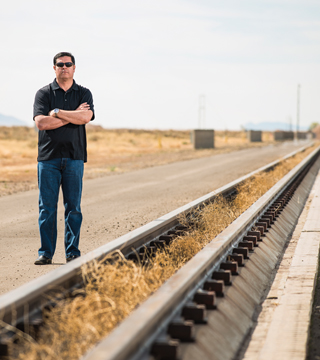
ON THE RIGHT TRACK — Sandia engineer and project manager Michael J. Vigil (1533) is part of a team that oversees tests done at the 10,000-foot rocket sled track. The wiring systems on the track were completely rebuilt during the Test Capabilities Revitalization. (Photo by Randy Montoya)
It sits in the heart of the New Mexico desert, windswept and quiet until a sudden, earth-shattering boom interrupts the tranquility. Sandia’s remote areas have long been known for their exciting test capabilities, and with a decade-long, $100 million renovation wrapped up this spring, the area will often be shaking, rattling, and rolling.
Some of Sandia’s most well-known tests have been conducted in this remote space, with its powerful and soaring structures. Wired magazine once said that if Sandia is the nation’s science playground, Tech Area 3 is its sandbox.
While the tests conducted there are admittedly fun to watch — and it’s hard not to get excited about the “shake, rattle, and roll” aspects — the mission couldn’t be more serious. The Tech Area 3 facilities are critical to supporting Sandia’s ongoing nuclear stockpile modernization work on the B61-12 and W88 Alt, assessments of current stockpile systems, and test and analysis for broad national security customers. But the test sites were aging. Many were built in the height of the Cold War and needed to be updated. A 2000 study indicated that to maintain Sandia’s test capabilities, new facilities and upgrades were needed. That study prompted the massive Test Capabilities Revitalization (TCR). Below is the first in a series of stories in the Lab News that will take a closer look at the recent upgrades.
* * *
Arguably one of the most famous of Sandia’s test facilities, the iconic 10,000-foot rocket sled track is known for its bright flashes, sonic booms, and sending large objects careening down the track at roughly the speed of sound.
The Rocket Sled Track offers a controlled environment for high-velocity impacts, aerodynamic and acceleration testing, and other conditions. Over the years, it has tested parachutes, aircraft, and space vehicles, and can also be used to support open-air burns.
More operational flexibility
“The TCR updates have given us a more robust and reliable facility. All the test control and instrumentation wiring systems and trackside boxes were replaced,” says engineer and Rocket Sled Track Facility Director Michael J. Vigil (1533), who is part of a team that oversees tests at the Sled Track. He adds that the new trackside boxes provide more operational flexibility and more robust data. “It gives us increased confidence that we understand all our electronic signals and where they’re going.”
Paul Schlavin, who oversaw the TCR updates, estimates his team put in 120 miles of new wire up and down the track, with 25,000 connection points. “We completely rewired the power and data acquisition,” he says. “It’s a whole new system, and it’s now a really robust system with fiber optics, camera stations, and blast-resistant walls to ensure that the system is protected.”
In addition to new wiring, controls, and electronics, TCR provided funding to renovate existing buildings and tear down those that were aging. The result is a more streamlined system for conducting tests. With new wiring and trackside boxes located at regular intervals down the track, the operations can all be controlled from the Rocket Sled Track Control building. In the past, Sandia engineers relied on temporary wiring to a mobile trailer or other building in closer proximity to the tests.
Sandia’s Rocket Sled Track is unique to the DOE complex and plays an important role in the overall weapons qualification process by validating many of the weapon systems’ models. “We serve an important function in verifying and validating that those models are accurate or can be changed to be more accurate based on the real data that we provide,” Michael says.
In the weeks and months to come, the team will rerun previous tests to ensure the life extension programs of some previously tested weapons are still valid. Upcoming tests also include shipping containers that hold radioactive materials to make sure they’ll meet requirements.
“We’re looking forward to moving ahead with more effective and robust testing,” Michael says. “I think success will breed success, and we’ll be able to do more tests at a higher level of quality with the recent upgrades.”